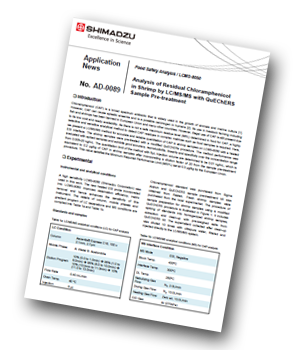Shimadzu has produced an application note describing the analysis of residual chloramphenicol in shrimp by LC/MS/MS with QuEChERS sample pre-treatment.
 Introduction
Introduction
Chloramphenicol (CAP) is a broad spectrum antibiotic that is widely used in the growth of animals and marine culture. However, CAP can cause aplastic anaemia and is a possible carcinogen in humans. Its use in livestock farming including fish and shrimps has been banned in the European Union and many other countries.
Here, we present an LC/MS/MS method for accurate and reliable quantitation of CAP in shrimp samples on an LC/MS/MS with a heated ESI interface.
Experimental
A high sensitivity LCMS-8050 (Shimadzu Corporation) was used. The new heated ESI probe incorporated into LCMS-8050 improves desolvation efficiency, matrix removal and hence enhances the sensitivity of this instrument.
Results and Discussion
A MRM quantitation method for chloramphenicol was developed on LCMS-8050 using an ESI interface. The MRM optimization was performed in negative mode using an automated MRM optimization program with LabSolutions workstation. Two optimized MRM transitions for chloramphenicol were selected; the first transition was used for quantitation and the second transition for confirmation.
Conclusion
The performance of the method was evaluated thoroughly, including linearity, accuracy and repeatability. The results obtained from matrix effect and recovery indicated that the LC/MS/MS method with simple QuEChERS sample pre-treatment is highly sensitive and reliable in detection and quantitation of chloramphenicol in shrimp samples.




